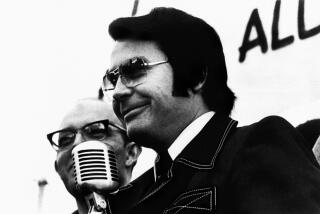The Many Quests for the ‘Real’ Jesus
- Share via
Imagine a convocation of New Testament scholars in the next century poring over a recently discovered cache of ancient scrolls. What a delightful, mystical figure Jesus cuts here! He’s hardly like the fire-and-brimstone version promoted in the establishment Gospels. Surely this is the real Jesus, the one suppressed for so long by a rigid hierarchy. Sad, isn’t it, this group realizes, that all previous generations of scholars were too hidebound and fundamentalist to perceive the truth. Like those folks in the Jesus Seminar, who at the end of the 20th century tried to identify Jesus’ actual words.
In “Hidden Gospels,” a survey of the ancient gospels that aren’t a part of the New Testament, Philip Jenkins proposes that such a scenario is both amusing and nearly inevitable. Ever since the dawn of the Enlightenment, Western Christian scholars have been trying to throw the churchified Jesus out the window and replace him with a more appealing figure. Yet there’s a catch: For the current generation of liberators to believe they are breaking new ground, they must forget that previous scholars did the same thing.
It’s the “underlying mythological structure” perpetuating this cycle that interests Jenkins. The discoveries themselves don’t warrant the astonishing claims made on their behalf, so some other need is driving their enthusiastic promotion.
Take as an example the ancient document “The Gospel of Mary.” It concerns a revelation of the risen Jesus to Mary Magdalene, and because it depicts her in a leadership role it is prized by contemporary feminists. But for it to constitute evidence of Jesus’ intentions for the role of women, “The Gospel of Mary” would have to have been written when the other Gospels were, about AD 80. A later, fictitious account would be as useless as a historical romance written last year. Unfortunately for fans of this gospel, its contents suggest a date of AD 180 or later. Its style and concerns resemble Gnostic mythologizing of that later era, and although it can teach us much about the controversies of the time, it can tell us nothing about the historical Jesus or Magdalene.
A hundred years ago, the “Pistis Sophia” played a remarkably similar role. Published in 1896, this document featured a mystical dialogue between Jesus and Mary Magdalene. In 1909 the feminist and theosophist Frances Swiney wrote “The Esoteric Teachings of the Gnostics,” based on “Pistis Sophia” and celebrating the superiority of its spirituality over the establishment church. Swiney praises Gnostic women as “pioneers of the liberation movement of their sex.” Jenkins finds it significant that the same revisionist formulas keep reappearing, and that current generations maintain a firm amnesia about the crusades of earlier revisionists.
If recently discovered Gnostic texts resemble older ones, why do we keep thinking such scholarship is daring or new? “The whole idea of hidden gospels and lost Christianity . . . appeals at the level of myth,” Jenkins writes. The campfire story goes like this: The real Jesus was hidden by evil bureaucratic forces who wanted to bar people from the truth and reserve power for themselves. But wait, hidden documents have been discovered that can overthrow this conspiracy. Courageous people are fighting to bring the truth to light, despite powerful opposition from the oppressive church.
“Phrased in this way, modern perceptions of Christian history sound less like scholarly reconstruction than the sort of mythology common to many societies, with their tales of original innocence, catastrophic fall and fortunate redemption,” Jenkins writes.
During times of social change, people cling to interpretive stories that give meaning to life, featuring clearly defined good guys and bad guys. The good guys are the rebels, of course; this is particularly true in the context of American culture, in which both patriotic rejection of England and Protestant rejection of Rome feed the flames of romance. Bad guys are the evil Roman church, a stereotype that has endured for centuries. That ancient texts supply the proof for rebellion echoes another familiar theme, that of conservative biblical literalism grounding all things in biblical text.
Thus there exists a powerful desire to inflate the importance of recovered texts, to place them as early as possible in history, and to use them to challenge historic faith. The very fact that the texts had been hidden is taken, illogically, as proof that they’re true: If they didn’t contain important secrets, why were they hidden?
Jenkins explains his thesis in language that is both clear and fair. “Hidden Gospels” is admirably evenhanded and far from the taunting, self-righteous tone revisionists habitually level at conservatives. He relies on facts to speak for themselves, though there is one fact that points beyond itself toward something worthy of further contemplation on this spiritually significant weekend. “After so much alleged secularization,” Jenkins writes, “the faith that people are struggling to disprove is still Christianity.”


